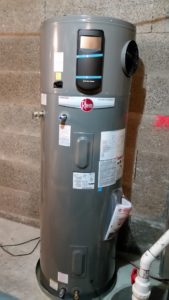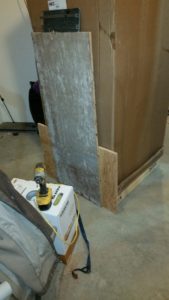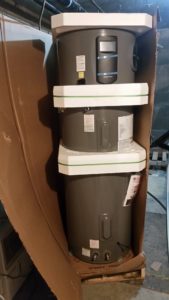Hot Water
Once again, I need to share my gratitude to another manufacturer that has seen the value this website provides to the public.
I am happy to announce Rheem has joined as a partial sponsor on this project, and I am thrilled that their Hybrid Hot Water Heat pump has arrived on site.
For this project, we are using their 80 Gal RHEEM Professional Prestige Series Hybrid Electric Water Heater Model PROPH80 T2 RH350 DC

Obviously, the larger the tank, the greater the capacity, and I wanted to make sure that if a family of 5 ever moves into the residence down the road (designed capacity of dwelling), there would be plenty of hot water for all. This tank will create 89 gallons of hot water in the first hour of demand.
The larger sized tank is especially important for a Hybrid hot water tank. Hybrid tanks are the most efficient hot water tank (HWT) on the market, but this efficiency is created by the fact that the recovery is a slower process, compared to gas or pure electric tanks.
There is of course two electric resistance elements in the tank for faster recovery/higher loads, but the pure heat pump mode moves ‘heat’ at a much slower pace from the air, to the water inside of the tank (much the same way as hybrid cars have Eco settings that remove some of the performance of the vehicle in return for more efficiency and longer range).
My road to deciding on a Hybrid Hot Water Tank was a very long one (indeed it took years!).
The dwelling was designed around an Air Source Heat Pump to Water space conditioning system. The original plan was to use this system to also create hot water. But because this house is so thermally efficient, the temperature of the water for the radiant system in the winter will only be 85°F at its hottest. This is all that is needed to keep the home toasty warm in the worst of the winter days. To give you a comparison, the water in hot water baseboards is usually 160°F to 180°F
85°F, is of course, far too cool for domestic hot water which should be stored up to 140°F (in areas with potential for bacterial growth in tank), and and delivered to the tap at 120°F to prevent scalding.
SO the search was on for a solution that met the energy efficiency demands I have for every other component of this build. I am not going to bring a natural gas line into the dwelling, so a gas HWT was off the menu (and really cannot be part of any plan that claims to have carbon footprint reduction as a project goal). This left the obvious choice of pure electric, but these are VERY expensive to run do to the large consumption of electricity and the cost of power in our region.
So the two ‘standard’ options were off the table. I then looked at the various options using an outside air source heat pump with some form of indoor heat exchanger. But these were prohibitively expensive ($5K+installation) and, in the case of the unit that uses CO2 as the refrigerant, have received poor reviews from end users in terms of reliability and hot water recovery performance.
So what was a person to do? Can’t live life without hot water (especially me with my buggered back!). The hybrid heat pump water heater had been recommended to me some time ago, but I had dismissed it for two reasons.
They can be noisy (especially in a high performance home that all but eliminates outdoor sounds by means of air tightness, triple pane windows, and high levels of insulation).
The second reason is that they will cool down the space they are in. This is because, they are actually extracting the heat from the interior air and transferring it to the water in the tank (this is similar, but opposite, to a fridge that extracts heat from its interior and dumps it into the air inside the house).
This makes them a no brainier for the south where their predominate loads are cooling, as this provides cooling as a byproduct! But for our heating dominated climate, I needed to make sure the number panned out.
I also initially dismissed the Rheem unit because I misread their specs. They require a minimum room size to service the tank (ensures enough air is available, at indoor ambient temperatures, to extract the energy it needs to heat the water). I believe the number is 500 (was not able to find when I looked now), and I misread this as square feet instead of cubic feet. I did not have a room in the basement that was 500ft2.
Finally, much later in the process, when I was giving up all hope of avoiding an electric resistance element tank, I re-read the specs and saw my error. I definitely had a room that was 500 CUBIC FEET, and in fact the room I am putting it into (large storage room under garage suspended slab), is 3500 ft3!
So the last hurdle was running the numbers to make sure that the payback for the added investment over an electric hot water tank was there for me. There had to be payback before the end of the 10 year warranty, and preferably much faster.
Now, our household is not your normal 2 person household. For me, baths are therapy. There are many days that I cannot stand fully straight up until I have had a hot bath. These same days often end in a hot bath after a long day at the job-site. With our hot water use, I calculated our annual needs to be around 30K Gals. This is closer in line to a family of 5, than a household of two, but a hot bath is still more effective, and cheaper, than any other type of therapy I could use.
I calculated our use, the cost of electricity, AND the added cost of providing additional space heating to that room during the heating season (don’t forget we are extracting the heat from the room’s air, so in the winter, we need to make up for this heat loss). Based on my calculations, the payback for the cost of the unit (from Home Depot’s website and comparing to a 100% electric resistance tank cost and performance), was as little as 2.91 years. An interesting fact is that the added cost of heating the room only added .16 of a year, because my heating production costs will be so low.
With this payback, it was a no-brainer to pursue this plan and I immediately approached Rheem, as they had the best user reviews and in my mind, the best technology. They are also a trusted name in the industry.
Thank-you to Mark Muzyka – National Sales Manager – Water @ Rheem for his generosity in approving this sponsorship.
I also want to thank Rob Newmarch @ Hy-Line Sales and Nigel Webb/David Popoff @ Emco for making the delivery happen!
I leave you with this quick video showing the movement of the tank from my trailer and down the stairs to the basement. This tank weighs in at a shipping weight of 281 lbs. Normally, I would have hired a laborer to assist in lowering it to the basement, but with the Covid situation, that was not going to happen. SO, I had to get creative and work smarter!
This ended up being much easier on my back than if I hired labour, as I have found so many times during this build.


